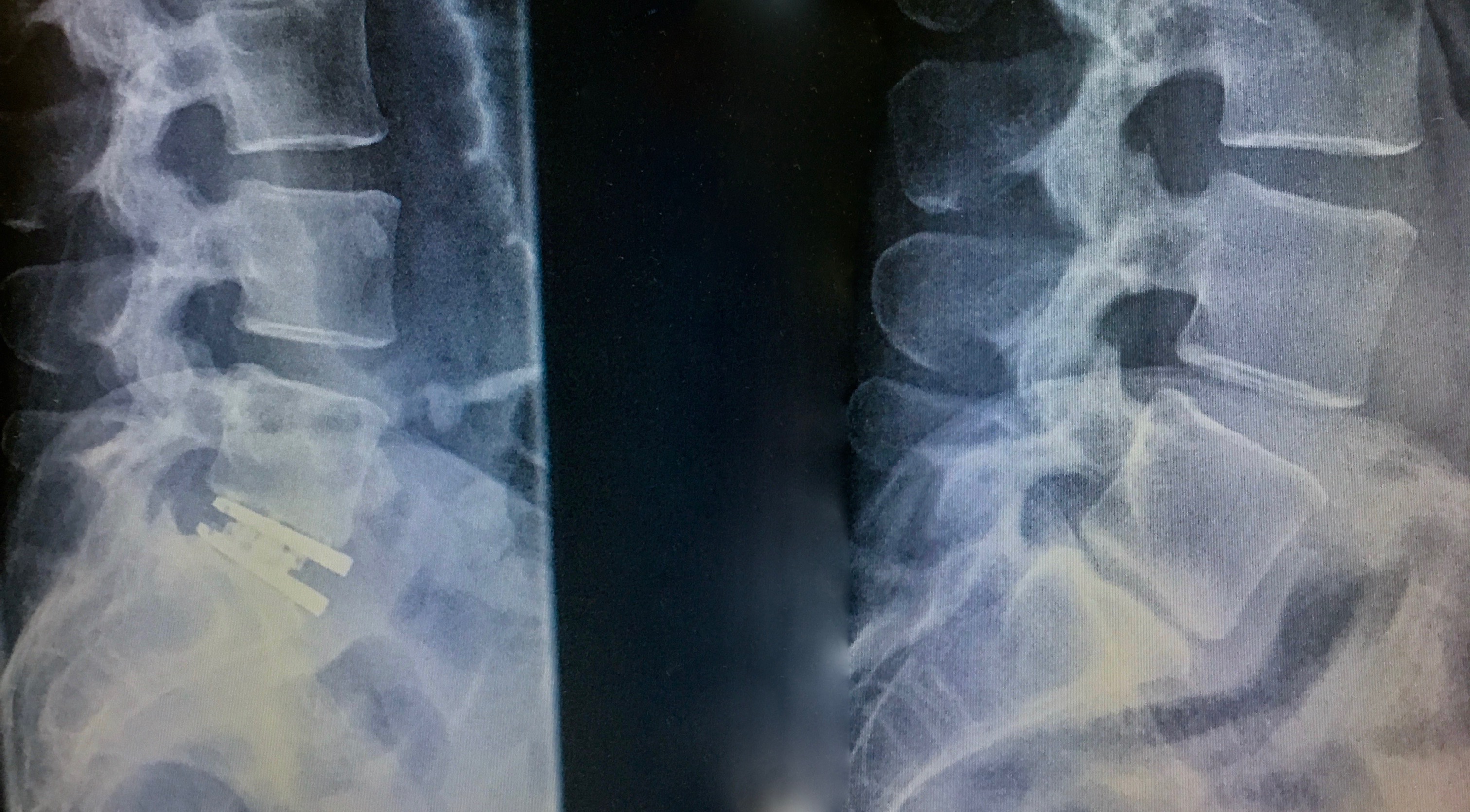The prospect of undergoing surgery that would alter the mechanics of my back forever motivated me to do research – a lot of research. What I found was quite amazing: over the last 20+ years, European surgeons haves been using “artificial disc replacements” (ADR), also called “total disc replacements” (TDR), in lieu of spinal fusion to mimic the mechanics of the natural spine and promote movement of the affected joint rather than immobilization.
The LP-ESP prosthesis is the artificial disc I chose for my lumbar spine. The journal article "The LP-ESP lumbar disc prosthesis with 6 degrees of freedom: development and 7 years of clinical experience" by Lazennec et al. (2013) was published in the "European Journal of Orthopaedic Surgery & Traumatology", and it gives a good overview of this amazing device.

So, what is an artificial disc replacement anyways? To me, it looks like a titanium Oreo cookie that is inserted in the cleaned-out disc space of the spine. Over time, the bone will grow firmly into the implant.
What makes ADR surgery so different from a fusion is the fact that it enables the spine to move in the affected segment, taking on its share of weight-bearing, which is supposed to protect the rest of the spine and allows natural range of motion (Abi-Hanna, Kerferd, Phan, Rao, and Mobbs, 2018). There are a variety of designs out there but in the US, the only FDA-approved discs for the lumbar spine are currently the “ActiveL” and “ProDisc-L" (as of May 2018).

By comparison, during a fusion surgery two or more vertebrae are being fused together with screws and other hardware to secure a bone graft (from either cadaver or autograft bone) where the natural disc used to be. This will lead to the vertebral bodies to grow together and fuse over time (Ullrich, 2013). This surgery can be done in different ways, either with an anterior, posterior, or lateral approach.
I found that each approach has its advantages and disadvantages but the outcome is ultimately the same: fusing together a joint that is meant to move. The reason why fusion has been used for so long to treat severe, chronic back pain is the underlying assumption that immobilization of the pain-generating segment will lead to pain reduction or elimination (Nie, Chen, Wang, and Zeng, 2015).
Another common complication of lumbar fusion is the accelerated adjacent segment pathology (ASP). ASP is a major complication that is caused by the increased stress above and/or below the fusion that is transferred to adjacent segments of the spine, causing those discs to break down faster. This often requires additional surgeries and more fusions within 5-7 years post-op (Lee and Choi, 2015).
A comparison study done by Lee and Choi (2015) did a follow-up on ADR and lumbar fusion patients after 13.2 years (average) post-op. The evaluation was based on RASP and CASP scores reported by both patient groups. By definition, CASP represents adjacent sentimental pathology with pain present, whereas RASP stands for radiological changes showing adjacent pathology without causing pain at that time. The outcome of this particular study showed a RASP rate of 34% among the fusion group compared to 9% of the ADR group. The CASP rate was 14% within the fusion group, whereas the ADR group reported a rate of 1% (2015). The overall conclusion was that ADR surgery reduces the incidents of ASP compared to traditional fusion surgery (Lee and Choi, 2015).
An updated review of literature that included relevant research data up to April 2017 has just been published in January 2018 in World NeuroSurgey. The study evaluated the outcomes of various ADR studies, and how ADR compared to fusion surgery. Abi-Hanna, Kerferd, Phan, Rao, & Mobbs (2018) found that ADR (in this case the ProDisc-L) has been superior to lumbar fusion for treating DDD, with significantly quicker recovery times, a preserved ROM, shorter hospital stays and operative times. The same study also pointed out that lumbar fusions have been criticized for problems involving insignificant pain relief, a reduced range of motion, and an increased risk of adjacent segment degeneration (Abi-Hanna et al., 2018).
To be transparent, many studies call for more research to solidify the long-term outcome of ADR, and the benefits of ADR significantly rely on perfect patient selection. However, I feel that fusing my spine at age 42 would have set me up for a future filled with pain, surgeries, and disability.
References
Abi-Hanna, D., Kerferd, J., Phan, K., Rao, P., & Mobbs, R. (2018). Literature review: lumbar disk arthroplasty for degenerative disk disease: Literature review. World Neurosurgery, 109188-196. doi:10.1016/j.wneu.2017.09.153
Jenis, L. (2016). Artificial disc replacement in the lumbar spine. Retrieved from https://orthoinfo.aaos.org/en/treatment/artificial-disk-replacement-in-the-lumbar-spine/
Lazennec, J.-Y., Aaron, A., Brusson, A., Rakover, J.-P., & Rousseau, M.-A. (2013). The LP-ESP® lumbar disc prosthesis with 6 degrees of freedom: development and 7 years of clinical experience. European Journal of Orthopaedic Surgery & Traumatology, 23(2), 131–143. http://doi.org/10.1007/s00590-012-1166-x
Lee, J. C., & Choi, S.-W. (2015). Adjacent Segment Pathology after Lumbar Spinal Fusion. Asian Spine Journal, 9(5), 807–817. http://doi.org/10.4184/asj.2015.9.5.807
Nie, H., Chen, G., Wang, X., & Zeng, J. (2015). Comparison of total disc replacement with lumbar fusion: A meta-analysis of randomized controlled trials. Jcpsp-Journal Of The College Of Physicians And Surgeons Pakistan, 25(1), 60-67.
Ullrich, P. (2013). Lumbar spinal fusion surgery. Retrieved from: https://www.spine-health.com/treatment/spinal-fusion/lumbar-spinal-fusion-surgery
